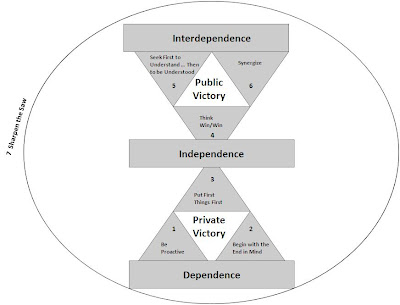Habit #4 - Think Win/Win (Work to find that 3rd solution that really is a win for everyone, instead of everyone, or one person, just compromising. With this attitude, no one has to compromise, and everyone can really buy into the solution, since it's actually better than what either "side" brought to the table.)
Habit #5 - Seek First to Understand, Then to Be Understood (I think/hope this one is self-explanatory. You can communicate more effectively when you really get where the other is coming from, not just the words, but the intentions, passions, and motivation behind their words and actions.)
Habit #6 - Synergize (This is working in a way that ensures the results are the very best efforts the team has to offer, truly valuing and leveraging everyone's strengths and diverse ideas and perspectives. To synergize, you must set up an environment where everyone is bringing everything they've got to the table, leaving no talents unutilized.)
After the first three habits focusing on ourselves, these are the three of the seven habits that teach us how to interact with others in a way that makes our collaboration more than the sum of its parts, better than what we each could achieve with only our own efforts/ideas/talents.
And here's an interesting look at a "problem" dog behavior - a dog learning to open doors and gates - from another blog:
"This is the very kind of creative ingenuity that enabled dogs to survive and thrive around hazardous human activities for the hundreds of years before we began to contain and control them. This is the dog’s default program. Why would we want to snuff it out and exchange it for the dutiful compliance of a measly few orders—what we call “commands”—we actually take the time to teach a dog? Who would want to trade an animal with such incredible potential for one who won’t or can’t do anything unless and until he his told or allowed? "
[Here's the link if you'd like to read the whole thing: http://conceptualdog.blogspot.com/]
The title of the blog's entry is:
"Trading Possibility for Control."
Wow. That to me hammers it home. This is what we do so often in the workplace. Just insert "employee" for "dog" in the excerpt above. We require compliance, but unwittingly buy it at the cost of creativity and enthusiasm. We forget habits 4-6, because they require us to honor the other person's (dog's) perspective, and communicate with them in a meaningful way. And that's hard a lot of the time. We make mistakes, and it's not pretty, it's not smooth. We need to make an investment in the other person (dog); to lay the groundwork of a strong relationship that can sustain minor miscommunications and keep on rolling. We need to truly accept and honor the other's perspective. So I think sometimes we learn to AVOID any kind of real collaboration. We inadvertently squash creativity and passion, because we either don't know how to channel it, or don't want to do the "extra" work it takes to turn it into a finished, collaborative product. I think we've all seen workplaces, and dog training classes/events, that have employees/dogs who are acting like mindless automatons, who if they take initiative to do anything on their own it's mostly centered around keeping a low profile so as not to draw fire.
I agree that every team needs a strong leader, who takes responsibility for developing and leveraging the members' talents, charts the team's course, and makes final decisions. But the fact is, if you truly commit to the kinds of actions and attitudes described by Covey in habits 4-6, you GET compliance. Willingly. To an often-better plan everyone genuinely buys into. Enthusiastically. Person or dog.
I say, trade your control for Possibility!

